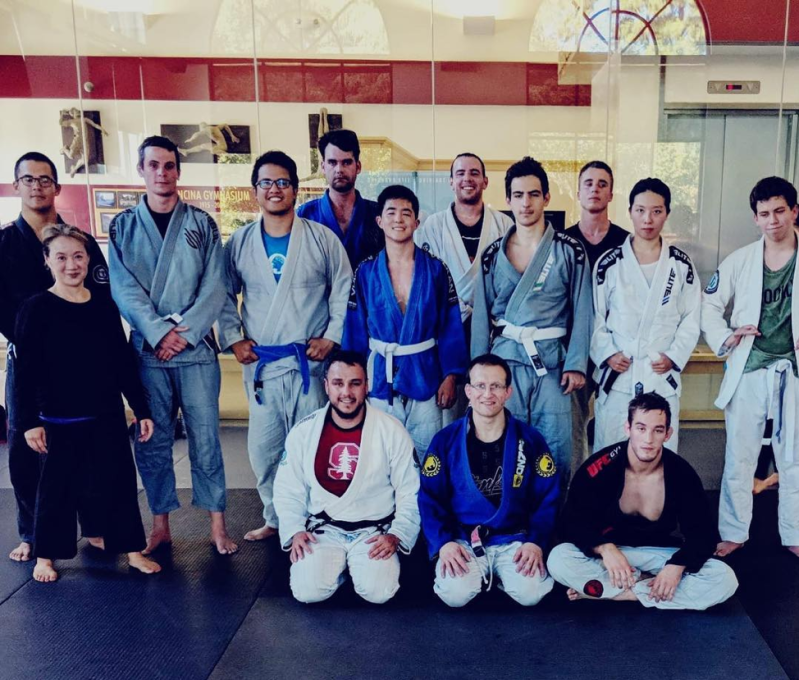Walk into the Arrillaga Center for Sports & Recreation at night, and odds are you’ll see a group of sweaty students rolling around in the mat room. It might look like a weird game of rolly-polly crossed with breakdancing, but it’s actually Stanford’s Brazilian Jiu Jitsu club. It’s something I’ve been a part of since I was a wee freshman — something fun and challenging, painful yet addictive. It is also in danger of disappearing.
If you aren’t familiar, Brazilian Jiu Jitsu is a grappling martial art focused on positional dominance and submissions and is widely used as a base for mixed martial arts. Think wrestling but joint locks and choke holds instead of pins. The great thing about jiu jitsu is that you can simulate combat (train against fully resisting opponents) without actually hurting your training partner, because once a submission is locked, your opponent can tap before any damage is done.
Within this paradigm lies many benefits. Since we train against fully resisting opponents, the execution of techniques can be battle-tested for effectiveness. There is no way to BS your way to the top or lie about your skills: if you claim to have a certain belt, it is expected that you back it up in sparring. This might seem like some macho movie-esque battle royale, but it is actually a key form of quality control that prevents fraud, or worse, a false confidence in techniques that aren’t exposed as ineffective until it is too late.
Training in jiu jitsu develops mental resilience. Beginning to grapple is like learning how to walk all over again: it is a new style of movement that requires learning new ways to think about how you move. An essential part of that learning is blindly losing, over and over again, to more experienced grapplers. This process normally lasts between three and six months. Losing feels real: tapping out means you are physically powerless under someone’s pressure/choke/lock and that your only method of escape is to give up. Come in night after night for months to willfully put yourself in that position in the pursuit of growth, and I’ll show you someone who is developing resilience.
Combat between two humans is as old as humanity itself. The clubs that train it fulfill a unique role at Stanford: combat brings abstract lessons into a personal, physical realm. You can skip your 9:30 a.m. Stats class and get by. Maybe your GPA drops by .01. But start skipping jiu jitsu, and your training partner, who you used to tool on last month, will start tooling on you. Want to challenge an expert? Online you could post a comment or just disagree and keep scrolling, but on the mats, you’ll feel the weight of the ten-thousand-hour difference. Literally. When you show up, you’ll know it is not for the money (spoiler: there is none) nor for the prestige (nobody cares if you can fight). And when you start training consistently and start tapping out the people that welcomed you in, you will know you have improved.
Stanford Jiu Jitsu is not tech. It is not innovative disruption. It is definitely not lucrative. But it is still an essential part of Stanford. Stanford’s Martial Arts Program (SMAP) is in danger under the new Stanford Recreation Administration (the name even rhymes, a sign of true evil). At the end of last year, we were banned for “diverging from university policies.” We have since successfully reapplied for recognition and regained our right to exist. Now, however, non-students are no longer allowed to train on the mats, a policy that prevents us from keeping our talent after they graduate. In martial arts, training with more skilled individuals is essential to growing talent; it is difficult to do so when the most senior students have only trained for four years. SMAP has also been relegated to the lowest priority on the queue for mat time behind yoga classes and club sports despite our large class sizes. It may not be in line with Stanford’s image of its recreation program, but the unique benefits of martial arts are a huge part of my Stanford life and the lives of the other students that love to train. If you agree, please let the administration know. And if you’re not sure, come try a class.
Contact Tai Kao-Sowa at tkaosowa ‘at’ stanford.edu.
